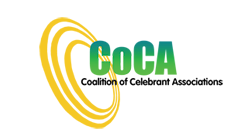Submission to the Select Committee on the Exposure Draft of the Marriage Amendment (Same Sex Marriage) Bill
Committee Secretary
Select Committee on the Exposure Draft of the Marriage Amendment (Same-Sex Marriage) Bill
Department of the Senate
PO Box 6100
Canberra ACT 2600
Phone: 02 6277 3228
Fax: 02 6277 5829
This email address is being protected from spambots. You need JavaScript enabled to view it.
Friday 13th January 2017
- This submission is made on behalf of the Coalition of Celebrant Association (CoCA) Incorporated, established on 16 October 2008.
- CoCA is recognised by the Commonwealth Attorney-General as the peak representative body for all Commonwealth-registered marriage celebrants. CoCA is comprised of 11 professional associations of marriage celebrants.
- The Australian Marriage Act was established in the middle of the last century based upon British legislation pioneered in 1836, and authorises a number of different types of marriage celebrants to provide valid marriage under civil law. 1
- Australia’s Civil Celebrant Program is a world first in that the marrying public can be married with a ceremony of their choice, at any location, time or day.2 This flexibility was introduced in 1973 under Section 39 of the Marriage Act.
- Along with Registry staff, Australia’s group of independent civil celebrants under Subdivision C of the Marriage Act was created to ensure civil law is upheld for any couple wanting their services.
- Civil celebrants now conduct 75% of marriage ceremonies in Australia.
- CoCA wishes to submit comments on sections (a) and (c) of the Committee’s Terms of Reference
Recommendations:
Recommendation 1:
That Section 47A as proposed in the exposure draft not be included.
Recommendation 2:
CoCA proposes that if the parliament decides to provide exemptions for independent professional civil celebrants, such exemptions should only apply to:
a. current authorised civil celebrants, not new civil celebrants, and
b. require those who object on “religious or conscientious grounds” to apply to the Commonwealth Marriage Registrar for an exemption in accordance with the legislation or re-assignment as an independent religious celebrant
Recommendation 3:
CoCA recommends that the definition of marriage in Part I—Preliminary, Section 5 Interpretation and all such associated references to marriage be amended to read:
"marriage means the union of two adults to the exclusion of all others, voluntarily entered into for life.”
Recommendation 4:
CoCA recommends that Subdivision C Marriage Celebrants be separated into two separate subdivisions – Subdivision C, Commonwealth civil celebrants and Subdivision D, Commonwealth Religious celebrants to enable the initial training and professional development of the two groups to be addressed separately.
- The Act was established in the middle of the last century based upon British legislation pioneered in 1836. Unlike France where all couples must attend a registry office to legally marry, couples in the Australian community may choose from 4 types of marriage celebrants.
· Subdivision A - Religious celebrants from Recognised Religions (22,880* - 72.1%)
· Subdivision B - Marriage Officers in State and Territory Registry Offices (293* - 0.9%)
· Subdivision C - Independent Civil Marriage Celebrants (8040* - 25.3%)
· Subdivision C - Independent Religious Marriage Celebrants (539*- 1.7%)
Total of all = 31,752
All marriage celebrants perform the same legal functions on behalf of the government, whether the ceremony is religious or civil, long or short. These functions are to:
• accept a Notice of Intended Marriage from the couple within the legal timeframe required
• assess whether the parties to the marriage are free to marry one another
• be satisfied with the identities of the couple and the information they provided
• complete the required documentation prior to the ceremony
• conduct a marriage ceremony after which the couple sign the relevant documents
• complete the processing of the marriage documents, and
• register the marriage with the relevant state or territory registry office.
This is because our Federal government granted this civil function of witnessing and registering a marriage according to civil law to these different groups including religious celebrants.
* Figures at 04-01-2017 - Unlike the UK, where couples can only marry in civil ceremonies at venues where the government designates Registry Office Staff to perform marriage, independent professional Subdivision C civil celebrants are authorised to marry anywhere within Australia.
Inclusion of independent professional civil celebrants in Subdivision C marriage celebrants is a world first and is unique as it allows personalised ceremonies for couples to:
· choose the marriage celebrant they want
· choose a venue, the time and day of the ceremony
· choose any number of guests
· choose the ceremony of their choice without discrimination on the basis of religion or personal conscience of the celebrant
The other subdivisions offer restricted or standardised services due to their organisational structure.


